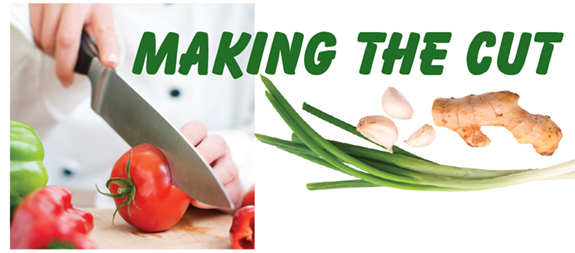 The unexpected culinary perks of a summer journalism internship
The unexpected culinary perks of a summer journalism internship
This summer, interning at Carolina Woman in Chapel Hill, was my first one away from my Raleigh home. I rented my first real apartment, with a kitchen that, for the first time, was not primarily used by my own favorite Carolina woman, my mom.
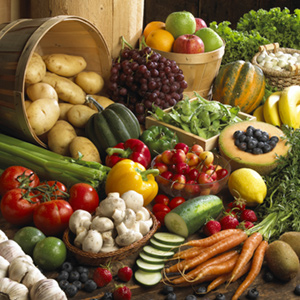 Most importantly, I realized for the first time how much effort goes into feeding yourself if there isn't a dining hall or a caring parent right around the corner.
Most importantly, I realized for the first time how much effort goes into feeding yourself if there isn't a dining hall or a caring parent right around the corner.
With a student's tight budget and a determination to eat healthy foods, I got creative. Turns out, too-ripe fruits and wilting spinach make a great power smoothie, and a can of diced tomatoes with a flurry of Italian spices makes a mean, lean and cheap spaghetti sauce.
Still, as I learned to navigate my tiny electric stove that backs up into the refrigerator, I knew I could use some help. I was wasting the ends of peppers that I couldn't properly chop. I hadn't had carrots on my salad in months – they seemed to shoot across the kitchen when I tried to shave them.
But I was in luck! My new boss, Chef Brack Johnson, occupied the office next to mine at Carolina Woman headquarters. Not only was he a recent culinary school grad, but he was launching his own cooking classes. My fellow intern, Marley Spence, and I were his trial run.
All about chef
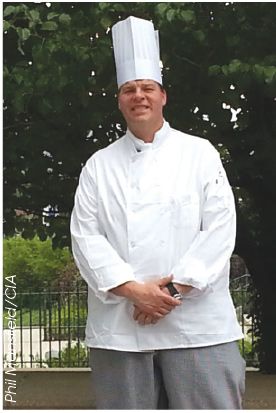 When Chef Brack was a child, he would run into his grandmother's house in West Virginia after a five-hour car ride from the Triangle knowing that made-from-scratch cornbread would be waiting on the stove. Later, he'd wander through her rural landscape, picking apples, strawberries and pecans for the pies and cobblers they would bake together.
When Chef Brack was a child, he would run into his grandmother's house in West Virginia after a five-hour car ride from the Triangle knowing that made-from-scratch cornbread would be waiting on the stove. Later, he'd wander through her rural landscape, picking apples, strawberries and pecans for the pies and cobblers they would bake together.
In those days, Chef Brack's favorites were biscuits and gravy, mashed potatoes, fried chicken...really, just about any dish of Southern comfort. By the age of 10, he was rustling them up in his family's kitchen. As a teenager, he worked as a fry cook and deli clerk; in college, as a line cook in a steakhouse.
Today, after traveling to 39 countries and 47 U.S. states, Chef Brack's tastes have broadened, but his roots in Southern kitchens have not been lost. It wasn't just the new flavors that changed Chef Brack's outlook on food. His increasing weight was becoming a major issue, and he knew something drastic needed to happen.
As he started cooking healthier foods, he began experimenting with ways to make them as savory and satisfying as the calorie-laden treats he used to enjoy. In the process, he lost 75 pounds.
It became Chef Brack's passion to create big flavors from wholesome ingredients. He looked to his Triangle community for more advanced skills to pass to readers of Carolina Woman, where he had signed on as food editor in 1993. Over a decade, he participated in scores of nutrition workshops at the Duke Diet & Fitness Center in Durham, the No. 1 rated medically supervised weight-loss center in the country.
In summer 2013, Chef Brack attended boot camp at the Culinary Institute of America, the nation's premier culinary school, in Hyde Park, N.Y. Chef Brack came home that fall and enrolled in Central Carolina Community College's natural chef program, which included instruction in gluten-free, farm-to-table and vegan cooking. He graduated with an associate's degree in applied science in the spring of 2016.
Chef Brack now makes everything from scratch with fresh, local ingredients. He has a motto for his culinary philosophy: "Awesome food that just happens to be good for you." And he's happiest when teaching other people how to make it.
Chef Brack's classes range from basic knife skills to secrets of healthy cooking. Marley and I took the class on knife skills, which is great for beginners.
Sharpening our skills
Marley will be a senior at UNC-Chapel Hill this fall; I'll be a junior. She used to get her meals at her sorority house, but won't be active this year. So, we're in charge of our own grub for the first time but can't cut a carrot!
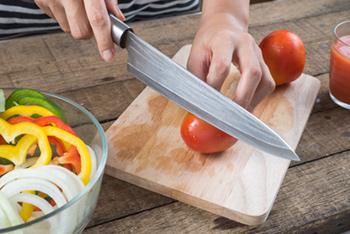 Marley and I arrived at Chef Brack's professional studio kitchen on a Saturday morning and quickly got to work. Since this class was specific to knife skills, the menu was designed accordingly. All of the recipes came from Chef Brack's training at the Culinary Institute of America's Best of Bootcamp.
Marley and I arrived at Chef Brack's professional studio kitchen on a Saturday morning and quickly got to work. Since this class was specific to knife skills, the menu was designed accordingly. All of the recipes came from Chef Brack's training at the Culinary Institute of America's Best of Bootcamp.
Before we started cooking, Chef Brack made sure we had properly organized our "mise en place," the French term for "everything in its place." This starts with being in the right physical and mental state of mind to cook safely and efficiently. It ends in having a clean workspace with all ingredients pre-measured and ready to use.
We learned about the different knives we would be using and their purposes. We examined the parts of the knives (did you know they have spines?) and how to safely wield and transport them around the kitchen.
Then, we read through all of our recipes. Chef Brack had helped us prepare by laying out ingredients beforehand. Now, we chopped, diced, julienned, peeled, chiffonaded, and brunoised them.
We were ready to begin cooking, the aprons Chef Brack lent us for the day already showing signs of hard work. We started with an Instant Cucumber Kimchi, the first on a list of Korean, Japanese and other Asian dishes we would prepare that day (although we did end with a seasonal and distinctly Western fruit crisp). It was a fun, full day of food, and Marley and I are ready to mix it up in our own (smaller) kitchens.
Try out one of the delicious recipes from our lesson below and let us know how you liked it. Whether it was a breeze for you, or you're ready to try a tougher challenge, check out Chef Brack's classes on carolinawoman.com. You can get in touch with him by email at chefbrack@carolinawoman.com.
Recipes
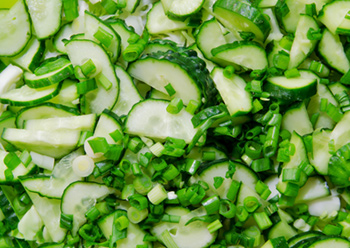 Instant Cucumber Kimchi
Instant Cucumber Kimchi
Yield: 6 Portions
European cucumbers 2
Salt 2- 1/2 tsp.
Daikon radish, julienne 1 cup
Garlic cloves, mashed 1
Green onions, finely sliced 2
Ginger, grated 1/2 Tbsp.
Korean chili powder 1- 1/2 tsp.
Sesame seeds, toasted 1 Tbsp.
Method:
1. Cut the cucumbers in half lengthwise. Scoop out the seeds and discard.
2. Cut the cucumbers into thin slices and place into a colander. Mix with 1- 1/2 teaspoons salt and set aside for 2 hours to drain.
3. Mix the julienned daikon with 1 tsp. of salt and let sit for 30 minutes.
4. Gently squeeze out the excess moisture from the cucumbers and daikon.
5. Transfer the cucumber and daikon to a mixing bowl and combine with the remaining ingredients; toss well to blend.
6. Serve cold, in a chilled bowl.
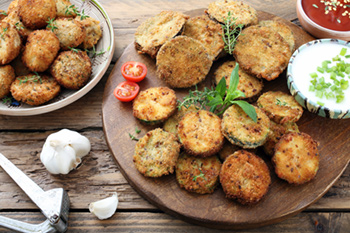 Vegetable Tempura
Vegetable Tempura
Yield: 6 Portions
Dipping Sauce
Dashi 1 cup
Mirin wine 1/3 cup
Light soy sauce 1/3 cup
Daikon, grated 1 cup
Ginger, grated 2 tsp.
Eggplant, small 1
Snow peas, trimmed 20
Button mushrooms, cut in half 6
Sweet potato, medium, peeled,
sliced into 1/4-inch-thick rounds 1
Batter
Egg yolk 1
Water, ice cold 1-1/2 - 2 cups
Baking soda 1/8 tsp.
All-purpose flour 1/2 cup
Rice flour 2/3 cup
All-purpose flour
(for no.4, below) 1/2 cup
Vegetable oil (for frying) as needed
Method:
1. To prepare the dipping sauce, combine the dashi, mirin and soy sauce in a saucepan and bring to a simmer. Remove from heat and stir in the grated daikon and ginger. Set aside.
2. If very large, cut the eggplant in half lengthwise and then cut into 1/4-inch-thick slices. Prepare the remaining vegetables as directed in the ingredient list and set aside.
3. To prepare the batter, combine the egg yolk with the ice cold water and baking soda in a large mixing bowl. Sift in the flours and mix well with a wooden spoon. The batter should be somewhat thin and watery and run easily off the spoon. Add additional cold water if necessary.
4. Dip the vegetables in the flour and shake off the excess.
5. Dip the vegetables in the batter and deep-fry in 375-degree oil until crispy and lightly browned.
6. Drain on a wire rack and serve immediately on a heated platter with the dipping sauce.
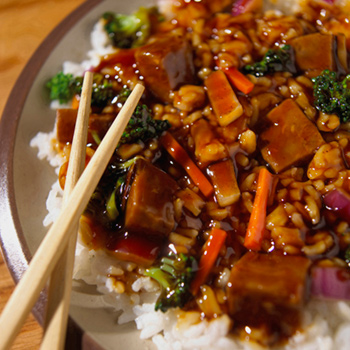 Beef Teriyaki
Beef Teriyaki
Yield: 6 Portions
Marinade
Light soy sauce 1 cup
Sake 1 cup
Mirin wine 3/4 cup
Sugar 1/2 cup
Fuji apple (or similar
variety), grated 1/2cup
Beef skirt steak 2 lbs.
Carrots, julienne 3
Broccoli, small florets 1 bunch
Vegetable oil 1/4 cup
Shitake mushrooms,
sliced 12
Bean sprouts 1 lb.
Salt to taste
Ground black pepper to taste
Sugar to taste
Method:
1. To prepare the marinade, combine the soy sauce, sake, mirin and sugar in a saucepan and bring to boil over medium-high heat. Add the grated apple and cook to reduce the liquid slightly – the flavor should be sweet and salty. Set aside and let cool.
2. Cut the skirt steak into 2- to 3-oz. portions and place into a mixing bowl. Add enough of the marinade to coat the meat well. Reserve the remaining marinade for use as a sauce.
3. Bring a large pot of salted water to a boil. Add the carrots and blanch (par-cook). Remove the carrots from the pot and place into a large bowl of ice water to stop the cooking process. (Shock them.) Set aside. Repeat the process with the broccoli, blanching the florets until they are vibrant green, then shocking in ice water. Combine the carrots and set aside.
4. Preheat a gas grill to medium-high; leave one burner off. If you are using a charcoal grill, build a fire and let it burn down until the coals are glowing red with a light coating of white ash. Spread the coals in an even bed on one side of the grill. Clean the cooking grate.
5. Grill the marinated steaks until browned and lightly charred on all sides. Use caution as the sugar in the marinade will tend to burn. Place the grilled steaks on a wire rack set in a baking sheet and finish in the oven until the meat is cooked to medium.
6. Heat the oil in a wok or skillet over medium-high heat. Add the mushrooms and stir-fry until tender. Add the blanched carrots and broccoli and continue to stir-fry until heated through. Add the bean sprouts and stir-fry, then season with salt, pepper and sugar to taste.
7. Thinly slice the steaks across the grain and serve over the vegetables surrounded by some of the reserved teriyaki sauce.
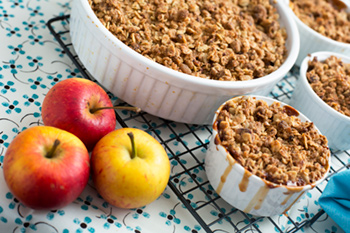 Seasonal Fruit Crisp
Seasonal Fruit Crisp
Yield: 10 Portions
Topping
All-purpose flour 3/4 cup
Sugar 1/2 cup
Brown sugar 1/2 cup
Ground cinnamon 1/2 tsp.
Salt 1/2 tsp.
Butter, chilled, cut into 1/2-inch pieces 10 Tbsp.
Nuts 1- 1/2 cups
Filling
Seasonal fruit, cut 5-6 lbs.
Sugar 1/2 cup
Lemon juice 1- 1/2 Tbsp.
Lemon zest, grated 1 tsp.
Method:
1. Preheat the oven to 375 degrees.
2. To prepare the topping, place the flour, sugar, brown sugar, cinnamon, nutmeg, salt and butter in the bowl of a food processor. Process until the mixture reaches the consistency of coarse cornmeal. Add the nuts and pulse until the mixture resembles crumbly sand. Refrigerate for at least 15 minutes.
3. To prepare the filling, toss the cut fruit, sugar, lemon juice and zest in large mixing bowl.
4. Transfer the fruit mixture to a large casserole dish and distribute the chilled topping evenly over the fruit.
5. Bake in the pre-heated oven for 55 minutes until the fruit is bubbling and topping is deep golden brown.
6. Serve warm or at room temperature.
Note: Prepare using a combination of seasonal fruits. Apples, pears, cranberries, blueberries, strawberries and rhubarb all make great choices!